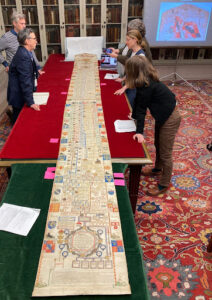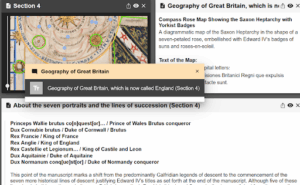15th century scroll gets 21st century treatment in transformative collaboration.
With funding from the American Branch, University of Pennsylvania professor Emily Steiner leads multi-disciplinary team in transforming a critical Wars of the Roses genealogy at the Free Library of Philadelphia into an interactive, online digital edition – unlocking its many symbols and messages for the public.
(Press Release: Philadelphia, Pennsylvania, September 4, 2025)
View the project online at https://www.library.upenn.edu/exhibits/chronicle-world

In the turbulent fifteenth century, rival claimants to the English throne presented their cases in elaborate genealogical rolls. One of the most colorful and nakedly partisan of these – a genealogy of Edward IV – has been digitized, translated, and presented online along with contextual annotations. The project showcases a unique piece of history and a unique partnership that brought this project to fruition.
“It has been so exciting to bring together students, scholars, librarians, and other interested parties to interpret this magnificent manuscript and to make it available to a worldwide audience,” explains Emily Steiner, A.M. Rosenthal Professor of English and project director. “We were grateful to have the financial and practical support of so many different partners. It was wonderful to be able to provide a research opportunity and financial support for our talented graduate students.” Steiner directed a team of graduate students who transcribed, translated, and researched the sources of the manuscript.
The Free Library’s Manuscript Lewis E 201 was acquired by Philadelphia attorney John F. Lewis in 1927 and donated to the library by his widow in 1936. Unique among the dozens of propaganda genealogies produced in this period, it displays multiple color-coded lines of descent reaching back to Adam and Eve and more than 50 heraldic shields and banners. The manuscript was conserved in 1998 and has been displayed in three exhibitions in the early twenty-first century.

“This is one of the crown jewels of the special collections in our library,” says Janine Pollock, head of special collections at the Free Library. “We are thrilled to see the manuscript made available online in this way. As it receives more and more attention from scholars, this digital edition means that they can study it without traveling to Philadelphia or unrolling this fragile item.”
The manuscript images and annotations are presented in the innovative Digital Mappa (DM) interface, an open source digital humanities platform developed by a team led by Martin Foy. DM lets the user select a specific image or block of text on a manuscript by clicking on highlights and borders, and bringing up transcriptions, translations, and annotations. The website offers instructions on how to navigate the interface.

“Digital Mappa provides two pathways to the content of the manuscript,” explains Dot Porter, the Schoenberg Institute for Manuscript Studies Curator of Digital Humanities at the University of Pennsylvania Libraries and technical lead for this project. “Users can navigate the manuscript visually, by viewing the images and clicking on specific items of interest. They can also navigate the manuscript via a series of text files, which present the transcriptions, translations, and annotations. It’s an ideal combination suited to a wide range of users.”
In addition to the scholars and students, members of the Richard III Society’s American Branch worked on the project. “We were delighted to provide financial support,” noted Susan Troxell, chair of the American Branch. “But we also provided hands-on assistance by mapping the images and inserting annotations under Dot’s direction.” The society’s team researched and annotated the major illustrations and the 54 coats of arms displayed on the manuscript. “Our membership includes a broad spectrum of academic historians to eager researchers, and this project gave them an opportunity to contribute to a major manuscript from the Wars of the Roses in a meaningful way. We don’t often find these opportunities and we were grateful for the chance to work with medieval scholars on such a transformative project. Now members of the general public can read the text in translation and understand the context of the imagery.”
The future Richard III is included in Edward IV’s family tree, where he is described as the brother to the king and duke of Gloucester. “It may very well be the first mention of Richard in an English royal genealogy,” says Susan, “as he was only 8 years old at Edward IV’s coronation and still young when Lewis E 201 is believed to have been created in 1461-64. One of the great mysteries is how this genealogy was used by Edward IV or whomever owned it.”
What is in the pipeline next for this manuscript and for others?
“We hope that this project will open the door to additional research on the manuscript,” observes Steiner. “Much remains to be done in terms of learning how medieval people viewed their history and used it to advance their claims in the power struggles of their time. The history presented in the manuscript is a remarkable blend of historical fact and myth – a combination that is ripe for exploration.” Funding for the project has been provided by the Price Laboratory for Digital Humanities at the University of Pennsylvania and the Richard III Society, American Branch.
“And we have our sights on other manuscripts,” adds Steiner. One of those, Ms Roll 1066 at the Penn Libraries, is another genealogy of Edward IV. It has been transcribed with the financial assistance of the Richard III Society, American Branch and is now being translated and annotated with the support of the Price Lab. For further information on this project, visit https://www.library.upenn.edu/exhibits/ms-roll-1066.
Inquiries about the project may be submitted to Susan Troxell, Chair of the Richard III Society American Branch, chairperson@r3.org
